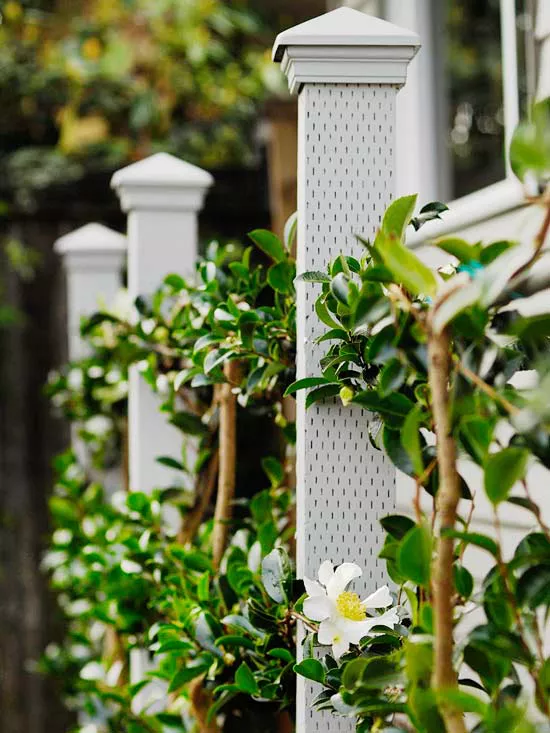How to Build a Living Fence for Privacy and Beauty

- Working Time: 4 hours
- Skill Level: Intermediate
- Estimated Cost: $100 to $150
- Yield: Planted 8-foot fence
Using standard pruning techniques, you can train dwarf fruit trees to form a living fence to enhance your yard's privacy and provide beauty and fresh produce. In a living fence, or espalier (pronounced es-PAL-yay), plants grow along a usually flat, symmetrical framework against a wall, trellis, or freestanding support. Frequent pruning and tying of new growth direct the plants into a decorative pattern, such as intersecting diamonds or horizontal arms or elbows.
Plan your espalier to meet your needs. For example, if you want fruit, select a peach, dwarf apple, or pear that is rock-solid hardy in your area. Or choose a blooming tree or shrub such as flowering crabapple, magnolia, or doublefile viburnum (Japanese snowball) for a purely ornamental living fence.
Although creating an espalier isn't particularly difficult, it does take time. Expect to wait three years for fruit, and plan to spend some time each year doing light pruning and training of branches.
What You'll Need
Equipment / Tools
- Posthole digger (optional)
- Hand pruners
Materials
- Three or more plants (dwarf fruit trees, for example)
- 4x4 posts (treated for soil contact or rot resistant cedar or similar wood)
- 2x4 top rail, 8 feet long
- 14-gauge wire
- Cloth-covered wire plant ties
Instructions
How to Build a Living Fence
-
Create a Support
Select an overall pattern for your living fence. (For our example, we selected a diamond pattern.) Build an appropriate framework of posts (8 feet apart), a top rail, and heavy-gauge wire horizontal supports. Stretch wire tautly from post to post, spaced vertically at 1-foot intervals, to create a framework. If you train trees against a wall, leave 12 inches between the structure and the support system to allow for maintenance and air circulation. Plant 2- or 3-year-old dwarf trees at least an arm's length apart.
-
Anchor the Plants
Make planting holes at least twice the diameter of the plant's root ball. Plant trees slightly in front of the wire supports. Refill the planting holes and water thoroughly. Water young trees weekly during their first summer and fall if rain is lacking. Cut off branches extending to the back or front; leave branches reaching to the sides.
If you train trees along a wall, position a nail or an eye hook in the wall near intersecting branches. Loosely twist a plant tie around the branches and the hook.
-
Train the Plants
Crisscross branches from neighboring trees to train them into the desired pattern for your living fence. Twist a plant tie around the branches and the wire to secure them, leaving room for branch growth. Over the next three or so years, prune and train trees in late winter. As the trees grow, continue to cross and tie the branches to the framework, snipping unwanted growth to maintain the pattern. Remove fruit buds for the first two years to concentrate the tree's energy into growing branches. Look for fruit in the third year.
Garden and Deck Privacy Ideas
- Patio Privacy Ideas to Help You Create an Outdoor Oasis
- Garden Privacy Ideas that Incorporate Landscaping and Hardscaping
- 18 Deck Privacy Ideas to Create a Secluded Backyard Retreat
- 7 Landscape Solutions to Make Your Backyard More Private
- 20 Best Evergreen Trees for Privacy and Year-Round Greenery